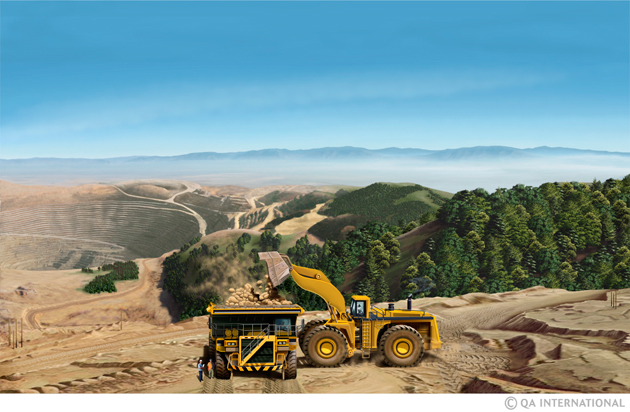
Metals and fossil fuels: the treasures buried deep in the rocks!
Some of the materials hidden in Earth’s crust are extremely useful to human beings. People dig hundreds, even thousands, of feet (or meters) underground to find them. They include metals like gold, iron, and aluminum, along with fossil fuels like coal, oil, and natural gas. Fossil fuels are an important source of energy. Metals are valuable as well. Most of them are hidden inside rock, which is known as ore, and are combined with a variety of other elements. Today’s advanced extracting and refining methods help mining companies obtain a wide variety of metals. Unfortunately, extracting metals and fossil fuels from underground cannot be carried out without scarring the landscape and upsetting the delicate balance of natural habitats.

How fossil fuels are created
Sometimes very large amounts of plants or tiny marine organisms become buried in sediment. Over time, they sink deep into Earth’s crust, where they are compressed and heated by the planet’s weight and high underground temperatures. After millions of years, these plant remains and dead tiny animals are transformed into fossil fuels. Forests that have been buried for millions of years turn into coal, while microscopic marine organisms turn into oil and natural gas. These highly combustible fuels are used for heating, producing electricity, and running vehicles such as cars.
Useful minerals
Most metals are hard, shiny, and strong. They are also very good conductors of heat and electricity. Metals are often mixed with other metals to form alloys. When copper and tin are mixed together, for example, the result is bronze, an alloy that is more solid and resistant than either of the two metals on their own. It is because of these many qualities that metals are used for so many different purposes.

Aluminum
Both light and strong, aluminum is used in the manufacturing of airplanes, cars, aluminum foil, and compact discs. It is extracted from an ore called bauxite.
Silver
Silver is a soft metal that is easy to bend and work with. Silver is used in photography, jewelry, ornaments, and electrical equipment.
Gold
Like silver, gold is used in jewelry, and also as a contact in electrical switches. Because gold is rare, it is also very expensive.
Copper
Copper is an excellent electrical conductor. It is used for making cooking pots, plumbing pipes, musical instruments, and electrical wires and cables.
Iron
Strong and bendable, iron is the most widely used metal in the world. It can be turned into wrought iron or into steel, a very strong alloy used in the construction of bridges. Iron is often extracted from an ore called hematite.
Mercury
Mercury is the only metal that is liquid at room temperature. Because it expands in heat, mercury is used in thermometers.
Making gold
During the Middle Ages, some people dreamed of transforming ordinary metals like lead into gold. They never succeeded. It is now theoretically possible for modern physics to manufacture gold but, surprisingly, nobody has ever succeeded in doing it! And even if they did, there would be one drawback: The process of making artificial gold would cost more than the real thing!
Also see

|
The "geology" section |
|---|---|

|
Earth: a rocky planet Earth’s crust is entirely made up of different kinds of rocks. Although they may appear solid and indestructible, rocks change continuously over time, forming, deforming, and transforming into other kinds of rock [...] |

|
Minerals and precious stones: Earth’s jewels Most minerals on Earth are formed when magma rises from the depths of the planet to the surface and then cools. [...] |

|
Our knowledge of geologic time How old are the oldest rocks? What was the climate on Earth 300 million years ago? When did aquatic life give way to land-based life? When did birds, conifers, dinosaurs, and flowers appear? [...] |

|
Configuration of the continents The continents are vast stretches of land surrounded by water, and they represent about one-third of the planet’s surface. Each one has very different characteristics [...] |







